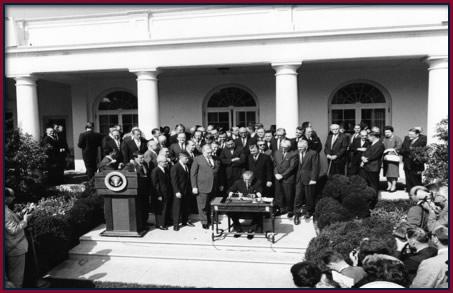In This Section
History of Community Action
What is Community Action?
In 1964, The Great Society, as envisioned by President Lyndon Johnson, was a sweeping plan to improve the lives of all Americans, regardless of their circumstances. Inspired by President Kennedy and his New Frontier, Johnson pledged to fulfill his promise of equal opportunity for all by enacting several comprehensive changes within the federal government. In August of that same year, the Economic Opportunity Act was signed into law by President Johnson creating the nationwide Community Action Network.
The War on Poverty
In 1963, shortly before he was assassinated, President Kennedy had asked his economic advisors to draw up some proposals to address the problem of American poverty. Johnson took up this charge after he succeeded Kennedy as President. In Johnson's first State of the Union address on June 8, 1964, he called for an unconditional war to defeat poverty. He expanded and revised the proposals given to Kennedy and developed the Economic Opportunity Act of 1964. The act included a variety of initiatives:
- Head Start
- Job Corps
- Work-Study program for university students
- VISTA (Volunteers in Service to America) - a domestic version of the Peace Corps
- Neighborhood Youth Corps
- Basic education and adult job training
- CAPS (Community Action Programs) - CAPS turned out to be the most controversial part of the package, as it proposed the "maximum feasible participation" by poor people themselves to determine what would help them the most. CAPS were a radical departure from how government had run most social reform programs in the past.

Photograph of President Johnson signing the EOA, August 1964
The Economic Opportunity Act was innovative legislation, but it received only about $1 billion to divide among the various programs and remained critically underfunded. By 1966, Congress appropriated $4 billion for the programs.
The Start of Community Action
Community Action was a bold idea, especially for the federal government. It handed over control to the local level, so that programs were geared specifically for target population needs. This concept, “maximum feasible participation”, represented a new paradigm in the government and many sectors were wary of its innovative ideas. President Johnson selected a member of President Kennedy’s inner circle to head up the newly formed “Office of Economic Opportunity” –Sargent Shriver.
Shriver was head of Peace Corps in the Kennedy administration and married to Kennedy’s sister, Eunice. He had proved himself to be a capable leader and President Johnson admired his abilities. President Johnson, legendary for his acumen in recruiting key personnel, offered the position to Shriver and would not take no for an answer. Shriver was installed as the first head of the OEO in October 11, 1964 and leapt into action.
Unfortunately for Shriver, he simply did not have adequate funding to begin the process of addressing national poverty issues. However, he assembled an impressive team of advisers, including Michael Harrington, author of The Other America and began to implement new policies and actions to resolve these issues.
Community Action was modeled after two fairly successful urban renewal projects, one undertaken by the Ford Foundation and the Mobilization for Youth, a program aimed at juvenile delinquency. Inspiration was also taken from the “Back of the Yards” program in Chicago, which was developed by Saul Alinsky, considered the father of “community development”. It should be noted that Alinsky became very critical of the OEO as it developed. The key component was that low-income citizens played an active role in program design and administration, or “maximum feasible participation”. The Economic Opportunity Act was amended (known as the Green Amendment) in 1967 to mandate the board structure of community action agencies, with complemented the earlier Quie Amendment which required the tripartite representation, including low-income participation.
In 1981, President Reagan introduced the Block Grant, which dramatically changed the way federal funding was distributed. Programs including Community Action, would now receive funding through the State Office of Community Action/Services and would be under more intense scrutiny then previous administrations. Illinois Community Action now worked more closely with the Illinois Department of Commerce and Economic Opportunity to implement the Community Service Block Grant (CSBG) and worked to build a strong partnership to provide robust services to Illinois’ low-income residents.
Over the past several years, federal funding to support the Community Service Block Grant has been challenged. President George W. Bush denounced Community Action programs as being static. However, Community Action remains an important safety net for many vulnerable individuals and families. Beginning in 2001, Community Action has improved their reporting through the Results Oriented Management and Accountability (ROMA) framework and continuously seeks ways to improve outreach and services. The National Community Action Partnership now encourages all Community Action Agencies to embrace the National Standards of Excellence as a pathway to improve and empower agency operations.
The guiding principle of maximum feasible participation continues today in Community Action. Local Community Action boards are tripartite, in other words, have representation from all segments of the local community including their low-income clients.

